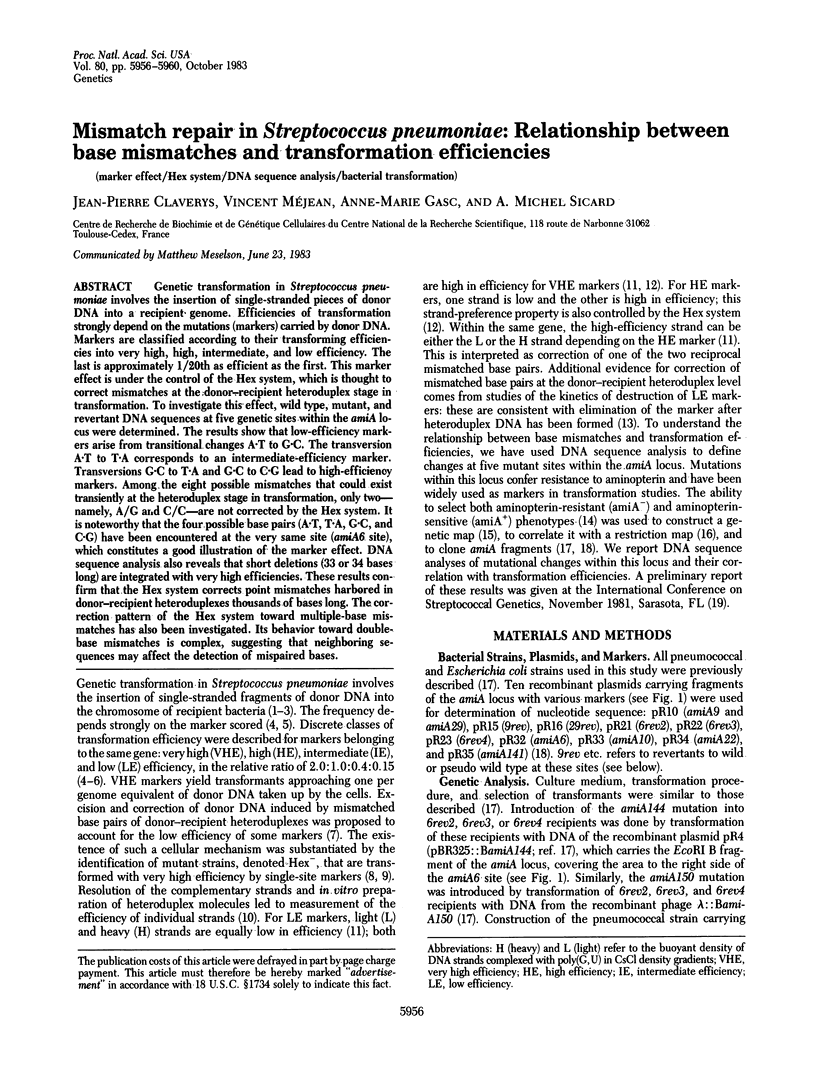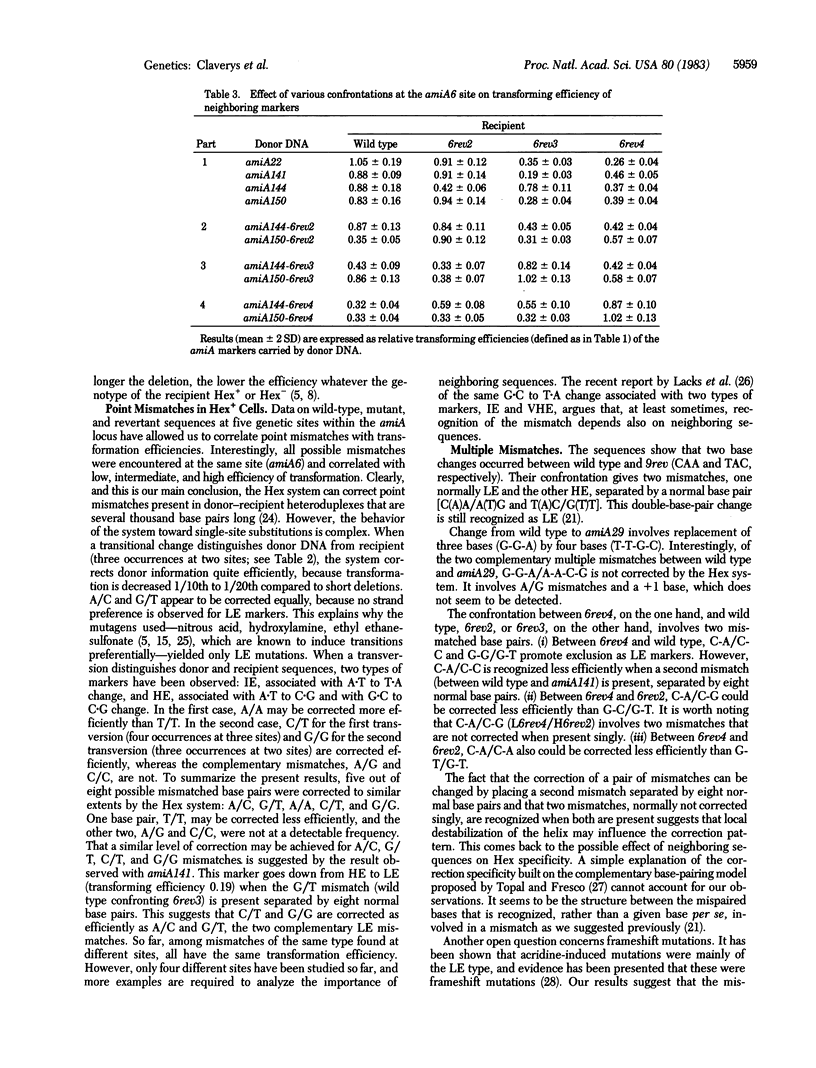Abstract
Genetic transformation in Streptococcus pneumoniae involves the insertion of single-stranded pieces of donor DNA into a recipient genome. Efficiencies of transformation strongly depend on the mutations (markers) carried by donor DNA. Markers are classified according to their transforming efficiencies into very high, high, intermediate, and low efficiency. The last is approximately 1/20th as efficient as the first. This marker effect is under the control of the Hex system, which is thought to correct mismatches at the donor-recipient heteroduplex stage in transformation. To investigate this effect, wild type, mutant, and revertant DNA sequences at five genetic sites within the amiA locus were determined. The results show that low-efficiency markers arise from transitional changes A . T to G . C. The transversion A . T to T . A corresponds to an intermediate-efficiency marker. Transversions G . C to T . A and G . C to C . G lead to high-efficiency markers. Among the eight possible mismatches that could exist transiently at the heteroduplex stage in transformation, only two--namely, A/G and C/C--are not corrected by the Hex system. It is noteworthy that the four possible base pairs (A . T, T . A, G . C, and C . G) have been encountered at the very same site (amiA6 site), which constitutes a good illustration of the marker effect. DNA sequence analysis also reveals that short deletions (33 or 34 bases long) are integrated with very high efficiencies. These results confirm that the Hex system corrects point mismatches harbored in donor-recipient heteroduplexes thousands of bases long. The correction pattern of the Hex system toward multiple-base mismatches has also been investigated. Its behavior toward double-base mismatches is complex, suggesting that neighboring sequences may affect the detection of mispaired bases.
Full text
PDF




Selected References
These references are in PubMed. This may not be the complete list of references from this article.
- Claverys J. P., Louarn J. M., Sicard A. M. Cloning of Streptococcus pneumoniae DNA: its use in pneumococcal transformation and in studies of mismatch repair. Gene. 1981 Jan-Feb;13(1):65–73. doi: 10.1016/0378-1119(81)90044-5. [DOI] [PubMed] [Google Scholar]
- Claverys J. P., Méjean V., Gasc A. M., Galibert F., Sicard A. M. Base specificity of mismatch repair in Streptococcus pneumoniae. Nucleic Acids Res. 1981 May 25;9(10):2267–2280. doi: 10.1093/nar/9.10.2267. [DOI] [PMC free article] [PubMed] [Google Scholar]
- Claverys J. P., Roger M., Sicard A. M. Excision and repair of mismatched base pairs in transformation of Streptococcus pneumoniae. Mol Gen Genet. 1980 Apr;178(1):191–201. doi: 10.1007/BF00267229. [DOI] [PubMed] [Google Scholar]
- Ephrussi-Taylor H., Gray T. C. Genetic studies of recombining DNA in pneumococcal transformation. J Gen Physiol. 1966 Jul;49(6):211–231. doi: 10.1085/jgp.49.6.211. [DOI] [PMC free article] [PubMed] [Google Scholar]
- Ephrussi-Taylor H., Sicard A. M., Kamen R. Genetic Recombination in DNA-Induced Transformation of Pneumococcus. I. the Problem of Relative Efficiency of Transforming Factors. Genetics. 1965 Mar;51(3):455–475. doi: 10.1093/genetics/51.3.455. [DOI] [PMC free article] [PubMed] [Google Scholar]
- FOX M. S., ALLEN M. K. ON THE MECHANISM OF DEOXYRIBONUCLEATE INTEGRATION IN PNEUMOCOCCAL TRANSFORMATION. Proc Natl Acad Sci U S A. 1964 Aug;52:412–419. doi: 10.1073/pnas.52.2.412. [DOI] [PMC free article] [PubMed] [Google Scholar]
- GUILD W. R., ROBINSON M. Evidence for message reading from a unique strand of pneumococcal DNA. Proc Natl Acad Sci U S A. 1963 Jul;50:106–112. doi: 10.1073/pnas.50.1.106. [DOI] [PMC free article] [PubMed] [Google Scholar]
- Gabor M., Hotchkiss R. D. Manifestation of linear organization in molecules of pneumococcal transforming DNA. Proc Natl Acad Sci U S A. 1966 Nov;56(5):1441–1448. doi: 10.1073/pnas.56.5.1441. [DOI] [PMC free article] [PubMed] [Google Scholar]
- Gasc A. M., Sicard A. M. Genetic studies of acridine-induced mutants in Streptococcus pneumoniae. Genetics. 1978 Sep;90(1):1–18. doi: 10.1093/genetics/90.1.1. [DOI] [PMC free article] [PubMed] [Google Scholar]
- Gasc A. M., Sicard A. M. Mutagenèse induite par l'hydroxylamine sur l'ADN du pneumocoque. C R Acad Sci Hebd Seances Acad Sci D. 1972 Jul 10;275(2):285–287. [PubMed] [Google Scholar]
- Glickman B. W., Radman M. Escherichia coli mutator mutants deficient in methylation-instructed DNA mismatch correction. Proc Natl Acad Sci U S A. 1980 Feb;77(2):1063–1067. doi: 10.1073/pnas.77.2.1063. [DOI] [PMC free article] [PubMed] [Google Scholar]
- Gurney T., Jr, Fox M. S. Physical and genetic hybrids formed in bacterial transformation. J Mol Biol. 1968 Feb 28;32(1):83–100. doi: 10.1016/0022-2836(68)90147-2. [DOI] [PubMed] [Google Scholar]
- LACKS S. Molecular fate of DNA in genetic transformation of Pneumococcus. J Mol Biol. 1962 Jul;5:119–131. doi: 10.1016/s0022-2836(62)80067-9. [DOI] [PubMed] [Google Scholar]
- Lacks S. A., Dunn J. J., Greenberg B. Identification of base mismatches recognized by the heteroduplex-DNA-repair system of Streptococcus pneumoniae. Cell. 1982 Dec;31(2 Pt 1):327–336. doi: 10.1016/0092-8674(82)90126-x. [DOI] [PubMed] [Google Scholar]
- Lacks S. Integration efficiency and genetic recombination in pneumococcal transformation. Genetics. 1966 Jan;53(1):207–235. doi: 10.1093/genetics/53.1.207. [DOI] [PMC free article] [PubMed] [Google Scholar]
- Lacks S. Mutants of Diplococcus pneumoniae that lack deoxyribonucleases and other activities possibly pertinent to genetic transformation. J Bacteriol. 1970 Feb;101(2):373–383. doi: 10.1128/jb.101.2.373-383.1970. [DOI] [PMC free article] [PubMed] [Google Scholar]
- Maxam A. M., Gilbert W. Sequencing end-labeled DNA with base-specific chemical cleavages. Methods Enzymol. 1980;65(1):499–560. doi: 10.1016/s0076-6879(80)65059-9. [DOI] [PubMed] [Google Scholar]
- Méjean V., Claverys J. P., Vasseghi H., Sicard A. M. Rapid cloning of specific DNA fragments of Streptococcus pneumoniae by vector integration into the chromosome followed by endonucleolytic excision. Gene. 1981 Nov;15(2-3):289–293. doi: 10.1016/0378-1119(81)90139-6. [DOI] [PubMed] [Google Scholar]
- Nevers P., Spatz H. C. Escherichia coli mutants uvr D and uvr E deficient in gene conversion of lambda-heteroduplexes. Mol Gen Genet. 1975 Aug 27;139(3):233–243. doi: 10.1007/BF00268974. [DOI] [PubMed] [Google Scholar]
- Roger M. Mismatch excision and possible polarity effects result in preferred deoxyribonucleic acid strand of integration in pneumococcal transformation. J Bacteriol. 1977 Jan;129(1):298–304. doi: 10.1128/jb.129.1.298-304.1977. [DOI] [PMC free article] [PubMed] [Google Scholar]
- Rydberg B. Bromouracil mutagenesis and mismatch repair in mutator strains of Escherichia coli. Mutat Res. 1978 Oct;52(1):11–24. doi: 10.1016/0027-5107(78)90091-x. [DOI] [PubMed] [Google Scholar]
- SICARD A. M. A NEW SYNTHETIC MEDIUM FOR DIPLOCOCCUS PNEUMONIAE, AND ITS USE FOR THE STUDY OF RECIPROCAL TRANSFORMATIONS AT THE AMIA LOCUS. Genetics. 1964 Jul;50:31–44. doi: 10.1093/genetics/50.1.31. [DOI] [PMC free article] [PubMed] [Google Scholar]
- Shoemaker N. B., Guild W. R. Destruction of low efficiency markers is a slow process occurring at a heteroduplex stage of transformation. Mol Gen Genet. 1974;128(4):283–290. doi: 10.1007/BF00268516. [DOI] [PubMed] [Google Scholar]
- Sicard A. M., Ephrussi-Taylor H. Genetic recombination in DNA-induced transformation of Pneumococcus. II. Mapping the amiA region. Genetics. 1965 Dec;52(6):1207–1227. doi: 10.1093/genetics/52.6.1207. [DOI] [PMC free article] [PubMed] [Google Scholar]
- Sicard A. M., Ephrussi-Taylor H. Recombinaison génétique dans la transformation chez le pneumocoque. Etude des réversions au locus amiA. C R Acad Sci Hebd Seances Acad Sci D. 1966 May 23;262(21):2305–2308. [PubMed] [Google Scholar]
- Tiraby G., Sicard M. A. Integration efficiencies of spontaneous mutant alleles of amiA locus in pneumococcal transformation. J Bacteriol. 1973 Dec;116(3):1130–1135. doi: 10.1128/jb.116.3.1130-1135.1973. [DOI] [PMC free article] [PubMed] [Google Scholar]
- Tiraby J. G., Fox M. S. Marker discrimination in transformation and mutation of pneumococcus. Proc Natl Acad Sci U S A. 1973 Dec;70(12):3541–3545. doi: 10.1073/pnas.70.12.3541. [DOI] [PMC free article] [PubMed] [Google Scholar]
- Topal M. D., Fresco J. R. Complementary base pairing and the origin of substitution mutations. Nature. 1976 Sep 23;263(5575):285–289. doi: 10.1038/263285a0. [DOI] [PubMed] [Google Scholar]
- Wagner R., Jr, Meselson M. Repair tracts in mismatched DNA heteroduplexes. Proc Natl Acad Sci U S A. 1976 Nov;73(11):4135–4139. doi: 10.1073/pnas.73.11.4135. [DOI] [PMC free article] [PubMed] [Google Scholar]


